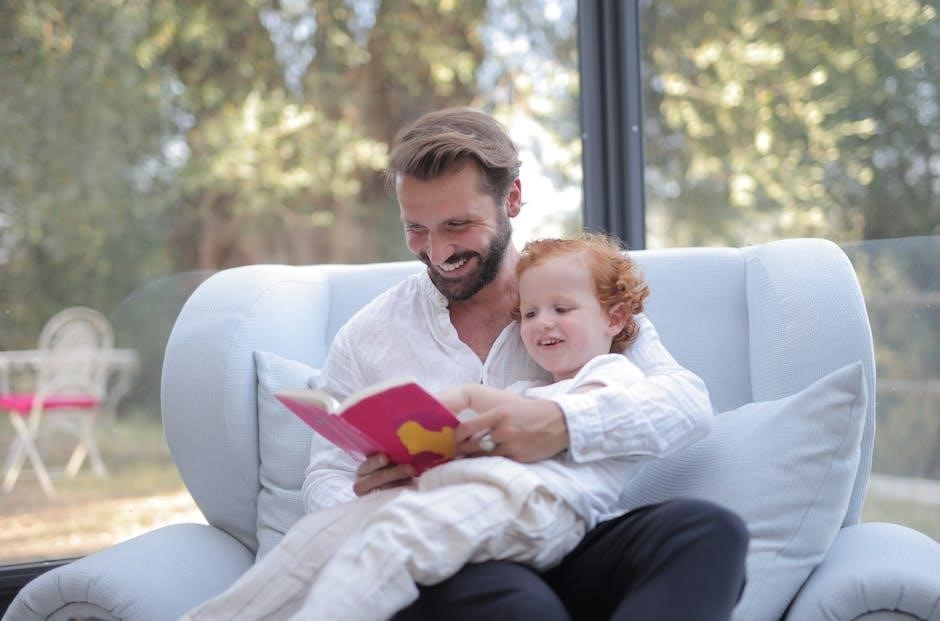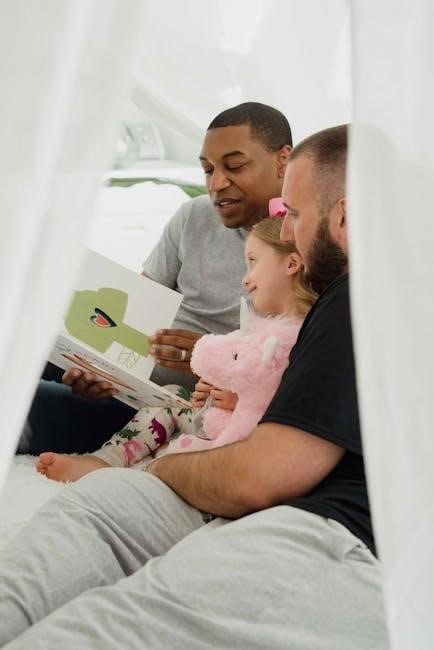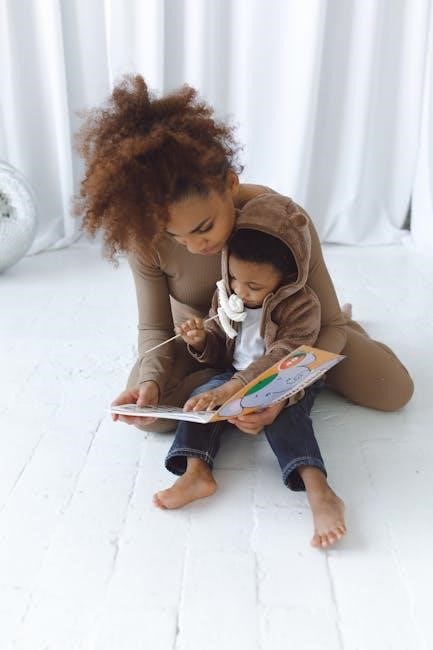Discover how adult attachment theory, explored by psychiatrist Amir Levine and psychologist Rachel Heller, revolutionizes understanding romantic relationships. This groundbreaking book reveals how early relationships shape adult attachment patterns, offering insights into anxious, avoidant, and secure styles. By providing practical tools like the ECR-R questionnaire, Attached empowers readers to identify their attachment style, foster emotional intimacy, and build lasting connections. A must-read for anyone seeking to enhance their relationship skills and find fulfilling love.

Overview of the Book and Its Importance
Attached: The New Science of Adult Attachment and How It Can Help You Find—and Keep—Love by psychiatrist Amir Levine and psychologist Rachel Heller introduces adult attachment theory as a revolutionary approach to understanding romantic relationships. The book explains how early interactions with caregivers shape adult attachment patterns, categorizing them into anxious, avoidant, and secure styles. By addressing the science behind these styles and offering practical tools like the ECR-R questionnaire, Attached provides readers with actionable strategies to improve communication, build trust, and foster lasting connections. Its blend of scientific rigor and accessibility makes it a vital resource for anyone seeking to enhance their relationship skills and understanding of love.

The Authors: Amir Levine and Rachel Heller
Amir Levine, a psychiatrist and neuroscientist, is an associate professor at Columbia University. His work focuses on attachment theory and its impact on adult relationships. Co-author Rachel Heller, a psychologist specializing in social psychology, brings complementary expertise to the book. Together, they blend scientific research with practical advice, offering readers a deeper understanding of attachment styles and how they influence romantic connections. Their collaboration provides a comprehensive guide to fostering healthier, more fulfilling relationships.

Core Concepts of Adult Attachment Theory
Adult attachment theory explores how early relationships shape adult bonding patterns, categorizing attachment styles as anxious, avoidant, or secure, and influencing relationship dynamics and emotional connections.
What is Attachment Theory?
Attachment theory, developed by John Bowlby, explains how early interactions with caregivers shape emotional bonds and relational patterns throughout life. It identifies three primary attachment styles—secure, anxious, and avoidant—each influencing how individuals perceive intimacy, trust, and relationships. Understanding these attachment styles helps individuals recognize their emotional needs, communication patterns, and compatibility with partners, fostering healthier and more fulfilling connections. This framework, as explored in Attached, provides a scientific basis for improving romantic relationships and personal growth.
The Three Attachment Styles: Anxious, Avoidant, and Secure
The three attachment styles—anxious, avoidant, and secure—shape how individuals navigate relationships. Those with an anxious style seek constant reassurance, fearing abandonment, while avoidant individuals prioritize independence, often distancing themselves emotionally. In contrast, secure attachment fosters trust, intimacy, and emotional balance. Understanding these styles, as outlined in Attached by Amir Levine and Rachel Heller, helps individuals recognize their relational patterns and improve communication, enabling them to build more harmonious and fulfilling connections.
How Early Relationships Shape Adult Attachment Patterns
Early relationships with caregivers lay the foundation for adult attachment patterns, influencing how individuals perceive intimacy, trust, and emotional connection. As explained in Attached, these formative experiences create a blueprint for adult relationships, shaping expectations and behaviors. Positive interactions foster secure attachment, while inconsistent or neglectful caregiving may lead to anxious or avoidant tendencies. Recognizing these patterns is crucial for understanding and transforming adult relational dynamics, enabling individuals to build healthier, more fulfilling connections in the future.

Identifying Your Attachment Style
Understanding your attachment style is key to improving relationships. Through self-reflection and tools like the ECR-R questionnaire, individuals can identify whether they are secure, anxious, or avoidant. Recognizing these patterns helps address insecurities and fosters emotional intimacy, enabling more fulfilling connections in the future.
Understanding Your Attachment Style Through Self-Reflection
Self-reflection is a powerful tool for identifying your attachment style. By examining past relationships and emotional responses, individuals can recognize patterns that align with anxious, avoidant, or secure tendencies. Levine and Heller emphasize the importance of exploring how early interactions shape adult behaviors. This introspective process helps uncover deep-seated fears and desires, enabling individuals to address insecurities and develop healthier communication habits. Through self-awareness, readers gain clarity on their emotional needs, paving the way for more fulfilling and balanced relationships.
Using the ECR-R Questionnaire to Determine Your Attachment Style
The ECR-R (Experiences in Close Relationships-Revised) questionnaire is a reliable tool for identifying attachment styles. Developed by Fraley, Waller, and Brennan, it assesses anxiety and avoidance tendencies in relationships. In Attached, Levine and Heller provide a modified version of this questionnaire, allowing readers to evaluate their attachment style through a series of questions about emotional responses and relationship behaviors. This practical exercise helps individuals gain clarity on their attachment patterns, enabling them to address insecurities and foster healthier connections with partners.
Recognizing Compatibility in Relationships
Understanding attachment styles is key to recognizing compatibility in relationships. Secure individuals naturally align with partners who value emotional intimacy and trust. Anxious and avoidant styles, however, often clash, creating cycles of pursuit and distance. Levine and Heller emphasize that compatibility isn’t just about shared interests but about how partners respond to emotional needs. By identifying attachment patterns, individuals can better assess potential matches and work toward building harmonious, secure connections that foster mutual growth and understanding.

Strategies for Building Stronger Relationships
Building stronger relationships involves understanding attachment styles, fostering emotional intimacy, and improving communication. Secure individuals naturally build trust and connection, while anxious and avoidant partners may need strategies to overcome their fears. Levine and Heller offer practical advice, such as using the ECR-R questionnaire to identify styles and developing empathy. By addressing attachment wounds and fostering a secure environment, couples can create lasting, fulfilling connections that promote mutual growth and understanding.
Communication Techniques for Anxious and Avoidant Partners
Communication is key for anxious and avoidant partners. Anxious individuals benefit from reassurance and emotional openness, while avoidant partners need space without feeling smothered. Techniques include active listening, emotional labeling, and gradual vulnerability. Levine and Heller suggest creating a “safe haven” for anxious partners by addressing their fears directly. For avoidants, encouraging independence while fostering trust can bridge the gap. These strategies help balance needs, fostering mutual understanding and strengthening the relationship dynamic between these contrasting attachment styles.
Building Emotional Intimacy and Trust
Building emotional intimacy and trust requires vulnerability and emotional responsiveness. Partners must create a safe space for open sharing, fostering empathy and understanding. Consistency in actions and words strengthens trust, while addressing past wounds can deepen connection. Levine and Heller emphasize the importance of emotional availability, encouraging partners to be present and attuned to each other’s needs. By prioritizing quality time and meaningful interactions, couples can cultivate a secure bond, laying the foundation for lasting emotional intimacy and mutual trust.
Practical Advice for Navigating Relationship Challenges
Navigating relationship challenges requires understanding attachment styles and fostering open communication. Identify triggers linked to anxious or avoidant behaviors and address them with empathy. Practice emotional responsiveness by actively listening and validating feelings. Regularly schedule meaningful conversations to maintain connection. Encourage mutual effort in conflict resolution, emphasizing teamwork over blame. Celebrate small wins to reinforce positive interactions. By aligning actions with emotional needs, partners can create a secure environment, transforming challenges into opportunities for growth and deeper connection.

The Science Behind Attachment Styles
The science behind attachment styles stems from early caregiver interactions, shaping adult relationship dynamics. Research highlights genetics and environmental influences on attachment patterns, impacting emotional connections.
Research Supporting Adult Attachment Theory
Extensive research, including studies by Bowlby, Ainsworth, and Fraley, supports adult attachment theory. The ECR-R questionnaire, developed by Fraley and colleagues, is widely used to assess attachment styles. Studies demonstrate that attachment patterns formed in childhood influence adult relationships, with secure attachment linked to healthier relationships. Neuroscience and psychology studies further validate these findings, emphasizing the role of early interactions and genetic predispositions in shaping attachment security.

The Role of Genetics and Environment in Shaping Attachment Styles
Genetics and environment collaboratively influence attachment styles. Research indicates that genetic predispositions can affect attachment security, while caregiving experiences shape attachment patterns. Secure attachment often results from responsive parenting, fostering trust and emotional resilience. Conversely, inconsistent or neglectful caregiving may lead to anxious or avoidant styles. This interplay highlights the complexity of attachment development, emphasizing that both innate factors and early life experiences are crucial in forming adult attachment styles.
How Attachment Styles Impact Relationship Dynamics
Attachment styles significantly influence relationship dynamics by shaping interactions, emotional responses, and intimacy. Secure individuals foster harmony through open communication and empathy, while anxious and avoidant styles often create conflict. Anxious partners may seek constant reassurance, causing friction, whereas avoidant individuals might withdraw, leading to emotional distance. These patterns can predict relationship satisfaction, with secure attachments promoting stability and insecure styles contributing to misunderstandings and dissatisfaction. Understanding these dynamics is crucial for building healthier, more fulfilling connections.

Cultural and Social Implications of Attachment Theory
Attachment theory highlights how cultural norms and societal expectations shape relationship behaviors, influencing attachment styles across diverse populations. While attachment needs are universal, their expression varies, reflecting cultural values like independence or interdependence. Understanding these dynamics aids in fostering empathy and improving cross-cultural relationships, emphasizing the theory’s relevance in a globalized world.

How Cultural Norms Influence Attachment Styles
Cultural norms significantly shape attachment styles by influencing how individuals perceive intimacy, independence, and emotional expression. Collectivist cultures often emphasize interdependence, fostering secure attachment, while individualist cultures may prioritize self-reliance, potentially leading to avoidant styles. Societal expectations around relationship roles and emotional openness also play a role. For example, some cultures encourage open emotional expression, promoting secure attachment, while others may discourage vulnerability, contributing to anxious or avoidant tendencies. These cultural influences interact with early caregiving experiences, shaping adult attachment patterns in nuanced ways.
Social Media and Modern Dating Trends
Social media has profoundly impacted modern dating, creating both opportunities and challenges. While platforms like dating apps offer vast potential for connection, they can also foster avoidance or anxiety. The abundance of choices may lead to a “grass-is-greener” mentality, hindering commitment. Additionally, the lack of deep emotional intimacy in online interactions can exacerbate attachment insecurities. Amir Levine and Rachel Heller’s insights in Attached help navigate these challenges, emphasizing the importance of understanding attachment styles in the digital age to build meaningful relationships.
The Universality of Attachment Needs Across Different Populations
Attachment theory’s principles, as explored in Attached, transcend cultural and societal boundaries, highlighting the universal human need for connection. Whether in Western individualistic societies or Eastern collectivist cultures, the desire for secure relationships remains consistent. Amir Levine and Rachel Heller’s work demonstrates that attachment styles—be it anxious, avoidant, or secure—are inherent across diverse populations, emphasizing the universal quest for intimacy and trust. This understanding fosters empathy and bridges gaps between individuals from varied backgrounds, promoting healthier, more compassionate relationships globally.
Attached by Amir Levine and Rachel Heller offers a transformative perspective on adult relationships, blending science with practical wisdom. Its insights have resonated widely, making it a trusted guide for fostering meaningful connections and understanding attachment styles. This book remains a vital resource for anyone seeking to enhance their relationship skills and find lasting love.
The Impact of “Attached” on Modern Relationship Science
Attached has significantly influenced modern relationship science by popularizing adult attachment theory. Its practical insights and tools, like the ECR-R questionnaire, have empowered individuals to understand and improve their relationships. The book bridges scientific research and everyday application, making complex concepts accessible. By focusing on attachment styles and their effects on dynamics, Levine and Heller have created a trusted resource for both professionals and the public, shaping contemporary approaches to love and relationships.
Resources for Further Reading and Exploration
For deeper exploration, the PDF version of Attached by Amir Levine and Rachel Heller is available online, along with epub and other formats. Additional resources include quizzes adapted from the book to identify attachment styles. OpenLibrary and academic platforms offer access to related studies and reviews. The book’s official website and author interviews provide further insights, making it a comprehensive resource for understanding adult attachment and improving relationships.
